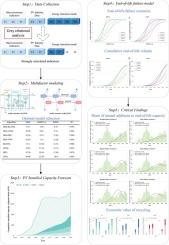中国光伏产业废物和回收潜力预测。
IF 7.1
2区 环境科学与生态学
Q1 ENGINEERING, ENVIRONMENTAL
引用次数: 0
摘要
在能源结构去碳化的推动下,光伏产业大规模扩张,导致光伏废弃物呈指数级增长。为了确保光伏产业的稳定发展,对中国未来光伏废弃物进行准确的宏观预测至关重要。本研究提出了一种基于长短期双向记忆 GRA 的多因素装机容量预测模型,用于预测中国 2024 年至 2050 年的累计光伏装机容量。利用威布尔分布和动态情景分析,对不同技术的电池板材料回收进行量化,并评估回收的潜在经济价值。结果表明,到 2050 年,中国累计光伏装机容量将达到 2,901 GW。在常规损耗的基准情景下,C-si、CdTe 和 CIGS 面板可分别累计回收 9975 万吨、4096 万吨和 529 万吨。分布式光伏发电将比集中式光伏发电产生更多的报废设备,估计最多可多出 11.8-0.5%。在所有情景中,回收设备的产能平均可达新产能的 64.7%,回收利用具有显著的互补效应。预计回收利用将产生 139.9 亿美元的经济效益。帮助决策者根据不同技术的回收材料采取措施。本文章由计算机程序翻译,如有差异,请以英文原文为准。

Projected waste and recycling potential of China’s photovoltaic industry
The massive expansion of the photovoltaic (PV) industry, driven by the decarbonization of the energy mix, has led to an exponential increase in PV waste. In order to ensure the stable development of the PV industry, it is crucial to make accurate macro forecasts of future PV waste in China. In this study, a multifactor installed capacity forecasting model based on long- and short-term bi-directional memory GRA is proposed to predict the cumulative installed PV capacity in China from 2024 to 2050. The Weibull distribution and dynamic scenario analysis are utilized to quantify the recycling of panel materials for different technologies and to assess the potential economic value of recycling. The results show that China’s cumulative installed PV capacity will reach 2,901 GW by 2050. 99.75 million tons, 40.96 million tons, and 5.29 million tons of C-si, CdTe, and CIGS panels could be cumulatively recycled in the baseline scenario of Regular loss. Distributed PV will generate more end-of-life equipment than centralized PV, up to an estimated 11.8–0.5 % more. In all scenarios, the capacity of recycled equipment averages up to 64.7 % of new capacity, with a significant complementary effect of recycling. Recycling is projected to generate $13.99 billion, with significant economic benefits. Helps decision makers to take measures based on recycled materials from different technologies.
求助全文
通过发布文献求助,成功后即可免费获取论文全文。
去求助
来源期刊

Waste management
环境科学-工程:环境
CiteScore
15.60
自引率
6.20%
发文量
492
审稿时长
39 days
期刊介绍:
Waste Management is devoted to the presentation and discussion of information on solid wastes,it covers the entire lifecycle of solid. wastes.
Scope:
Addresses solid wastes in both industrialized and economically developing countries
Covers various types of solid wastes, including:
Municipal (e.g., residential, institutional, commercial, light industrial)
Agricultural
Special (e.g., C and D, healthcare, household hazardous wastes, sewage sludge)
 求助内容:
求助内容: 应助结果提醒方式:
应助结果提醒方式:


